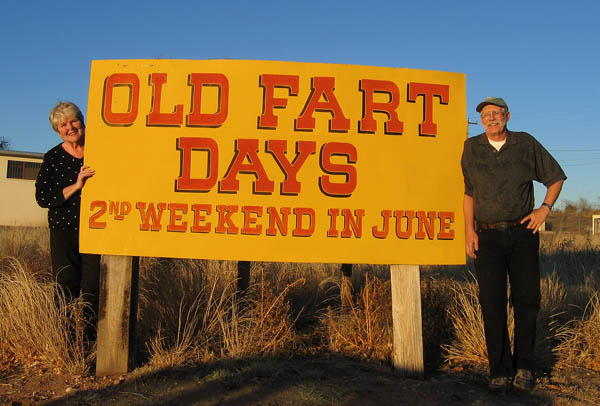29 Nov 2005
Winds of New Mexico
This November 26th, we be seriously buffeted by 40 to 50 mph winds,
parked next to a visibly disappearing lake in eastern New Mexico. To
give you an idea of the remoteness, we are on the weather forecast with
Muleshoe, Texas, and PBS plays Montovani.
When we drove into Fort Sumner last Saturday, the town was deserted;
even Dave’s Grocery was closed. Turns out there was a football game —
the Fort Sumner Foxes whupped the Texico Wolves for the State A-1
Championship. Yee-haw! The population of Fort Sumner is listed at
1,028; there were 1,127 people at the game.
We really, really like this little town. People are very welcoming.
They have a long, close relationship with the State Park we are
mapping, which was formed by damming the Pecos River. Sadly, Texas has
water rights on the Pecos and when Texas asks for water, Sumner Lake
goes down. We’re just hoping the lake doesn’t go away before we leave.
Four years ago it got so low all the fish died. From what we hear it
was a very unattractive situation.
Days are sunny and warm; we’re at about 4,200 feet, and nights get down
to freezing, though we never see any eidence of frost. It is very
flat. I tend to look at landscapes and paint them in my mind. There is
a lot of sky in these paintings. I made myself a fleece jacket and hat
yesterday, just in time, I think. (I made a turban hat out of red
fleece – they’ll love that in town, don’t you think?)
Billy the Kid died here. We think. There is a grave, caged against
thieves, and an ongoing battle to exhume the remains to make sure.
Another claim to infamy is the Bosque Redondo (round wood). The
tragically misguided attempt to relocate 10,000 Navajos from Arizona,
and just enough Apaches to rile them up, ended in what the Navajos
still call “The Long Walk.†It is now a state monument with a
beautiful museum.
After the reservation experiment failed, and the outlaws died and the
government left, the area was developed by wealthy Mexican landowners.
The original family names are still very evident, 150 years later.
People stay here. Half the people I’ve called on went to school with
the park superintendent. If young people leave, they come back to
raise their families. There is no industry and the town is dirt poor,
so it takes a conscious effort to live here. It is the most cohesive,
content community we’ve been in.
It is also the only town we’ve been in that has a windmill repair shop.
(Big one, very dark and oily and truck-shop smelly. I’m trying to sign
them up as trailer hitch welders).
We’re a little neervous about being this far north in December. They
get a little snow each year. But we signed up a nice park in Santa
Rosa, 30 miles north, and can see a real profit potential in it. (Took
it from the competition!) So we’ll be close to Muleshoe and Wagonwheel
for another 2 to 3 weeks. Santa Rosa is on Route 66, home to the Blue
Hole, a geologic phenomenon that offers a very deep, clear, freshwater
scuba experience.
Dave really has his work cut out for him here. He has had to build a
map of the park, almost from scratch. It is quite detailed and the
park people are really happy with it. Next he has to build a map of
the town, so we can pinpoint the location of the advertisers. Both of
them. (We knew this was going to be a tough job, but I’m still
confident.) Plus, he has to create ads for me – no one has any
advertising copy. He makes them for me to take on call backs, and itâ€s
helpful. I actually have four full ads sold (two are out of town) and
about five “most likelys.†I need at least seven to meet production
costs.

Love to all. Attached are pictures of our new favorite place. It’s part
of what we love about this job — it lets us be travelers instead of
tourists. We never would have come to this place, let alone stay two
weeks, unless we had a purpose. We’re so glad we didn’t miss it.

Sam